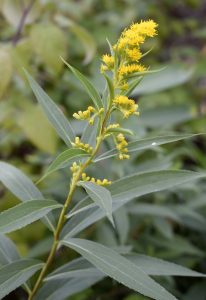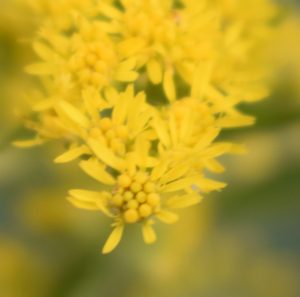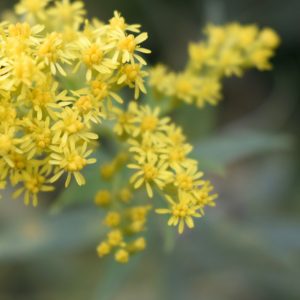Giant Goldenrod (and others)
 Solidago gigantea has one major ID characteristic that helps in identifying it from other Solidagos, a closely related group between which it can be hard to distinguish. Giant goldenrod has hairless stems, quite noticeable once you look for them. Tall goldenrod and Canada goldenrod, on the other hand, both have hairy stems.
Solidago gigantea has one major ID characteristic that helps in identifying it from other Solidagos, a closely related group between which it can be hard to distinguish. Giant goldenrod has hairless stems, quite noticeable once you look for them. Tall goldenrod and Canada goldenrod, on the other hand, both have hairy stems.


Blooming late season (August into October), ‘giant goldenrod’ flowers are about 1/4″ across with 9 – 15 petals surrounding a central disc (a fleshy lobed area of the flower) with 7 – 12 disc flowers located there.
In contrast, tall goldenrod and Canada goldenrod will have only 3 – 6 center disc flowers.
Goldenrod has been blamed for summer allergies and is often mistaken for the allergy-causing plant, ragweed. I admit to being one of those who grew up under the mistaken impression that goldenrod was the same thing as ragweed. I don’t know how this came about! For one thing, goldenrod’s pollen is sticky, and so pollination occurs mostly right on the plant from insects’ legs and feet. Being sticky, goldenrod’s pollen cannot become airborne like ragweed’s light, floating pollen can and does.
I am continually astonished at the plethora of Mother Nature’s gifts growing right in our midst that we have forgotten or let go, separating ourselves from Her. How has this happened? Goldenrod is a plant that offers so very much in the herbal medicine cabinet – urinary health and pain reduction to name two. The healing parts of goldenrod are in the leaves and flowers and can be harvested to use fresh or dried. Infusion of the oil works as well. Goldenrod contains the antioxidants quercetin and kaempferol, which are anti-inflammatory flavones – another beneficial attribute. Goldenrod acts as a diuretic which can be helpful for kidney health and heart conditions, ridding the body of excess fluids. It is taken as well to reduce back pain and to alleviate knee arthritis pain.
Try making a strong, tea infusion of the fresh leaves. First, chop a small handful (about 1/3 cup) into small pieces, then pour a cup of boiling water over this and let it sit for at least 15 minutes (one hour for strong) before straining. The resulting beverage is refreshing, mildly astringent, and not at all bitter.
The Latin word for goldenrod, Solidago, means to make whole or heal. I think that says it all!
